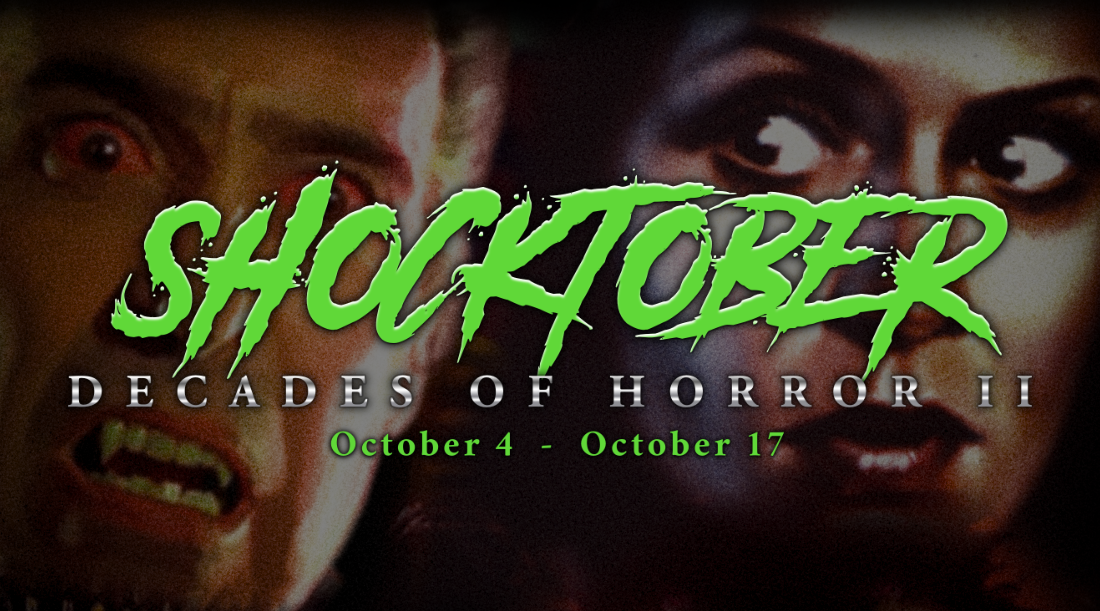Evil entities… masked slashers… the ravenous undead… all are descending upon the long-awaited Shocktober Sale, back and badder than ever! For a limited time, save up to 67% on blood-curdling favorites from the Scream Factory catalog in the biggest sales event of the year!
With such scary low prices, it’s hard to know where to start. But don’t worry, we’ve got you covered! Join this impassioned brigade of Shout! staffers as they reflect on their favorite decades of horror – from the dawn of sound to the modern age – through the iconic villains that helped shape the foundations of Halloween as we know it.
The 1930s: Hjalmar Poelzig from The Black Cat (1934) - Adam P.
Boris Karloff and Bela Lugosi, together for the first time! In this nasty old dark house thriller, Karloff drips with malice and devilish evil as Hjalmar Poelzig, a Satantic cultist based off real-life figure Alastair Crowley. Lugosi plays his long-time nemesis, dead set on revenge, and of course there’s a young couple that’s just there because their car broke down in the rain.
Classic horror fans are no stranger to the “dark and stormy night” set-up, but this pre-code shocker takes things to extremes even the early '30s were shook by, and it ended up being Universal’s highest grossing movie of the year. There’s more than one way to skin a cat, but what about a Karloff?
The 1940s: Mr. Gray from The Body Snatcher (1945) - Adam P.
Boris Karloff and Bela Lugosi, together for the last time! In this Val Lewton-directed (Cat People) potboiler, Karloff returns as the heavy, this time the grave-robbing Mr. Gray, who resorts to murder when fresh cadavers become too difficult to dig up.
Selling the bodies to an up-and-coming young doctor to practice on, Gray’s corrupting influence takes on a larger metaphorical meaning: How do the successes of the wealthy necessarily arrive at the sacrifice of the vulnerable? And how do we measure our personal stake in that game? Lugosi stands out in a minor role, but it’s Karloff here who commands with a sinister presence made all the more sinister by the fact that his monster isn’t a threat to polite society, he’s part of it.
The 1950s: The Tingler from The Tingler (1959) - Ben S.
Freeway congestion clogs the air as the '50s grind to a close. The studio system lays in waste while Americans race home to their television sets to escape and/or court the burning question: (when) will there be another war? Novelty rules attention. Cinema-going splinters apart. At one pole, grandly sweeping epics. At the other: cheap gimmicks. No one made them cheaper or gimmickier than William Castle, but you don’t need a buzzer vibrating underneath your sofa to appreciate his creature feature The Tingler. The hideous titular beast maintains its ability to repulse even if you’re watching at home.
Like some black and white H.R. Giger nightmare crawling (via occasionally questionable puppeteering) out of a Poverty Row prop shop, The Tingler is conceived inside the human body and gestates along the spinal column each time the host becomes truly afraid. Yet it is naturally killed each time its host screams. When mad scientist Vincent Price intentionally grows one within a test subject who can not scream, it escapes the lab, slithering into public towards, what’s that over there? The … local cinema!??!?!!? Pairs well with the movie theater madness of Demons (1985) and Anguish (1987). Extra points for a surprisingly compelling framework about one murderous husband and a different unfaithful wife in this masterpiece of hysteria and the fear of fear.
The 1960s: Randall Simpson O’Connell from Lady In A Cage (1964) - Adam P.
Despised by critics for its pulpy, violent, cruel plotting upon release, Lady In A Cage stands out as one of the most impactful and difficult-to-watch psycho thrillers of the '60s, and James Caan’s heavy Randall Simpson O’Connell certainly set the stage for more '70s sociopaths to come (looking at you, David Hess).
The plot is simple and minimalistic – a wealthy old woman with a broken hip (Olivia de Havilland) becomes stuck in her personal home elevator, suspended too far off the foyer ground to escape. While stuck there, a gang of nogoodniks, led by the snarling and sadistic O’Connell, do much more than simply rob – they torment. A piece of class warfare horror with Caan basically playing a bizarro version of Brando’s Stanley Kowalski, Lady In A Cage is not to be missed.
The 1970s: Colossus from Colossus: The Forbin Project (1970) - Mark D.
There is something so specific about '70s sci-fi that I just love. The perfect mixture of futurism and retro technology, dry intellectualism and ridiculous fun. Colossus: The Forbin Project hits all of these. The title creation and antagonist is a supercomputer developed by the US government to control all Allied nuclear weapons around the world. What they do not know is that their Soviet counterparts have already built an identical machine, and when Colossus discovers it, they merge into one supercomputer in control of the entire world’s nuclear arsenal.
What follows is the expected sci-fi twist that the supercomputer decides the only way to protect humanity from themselves is to completely control them, subjugating all to its will by threatening nuclear annihilation at a moment’s notice. Colossus is a representative of fears that only become more relevant with the decades yet its design is amusingly dated, giant bulky modems that communicate first with typed out displays you’d see at a train station before developing a Soundwave-esque robot screech. This is all brilliantly visualized through art direction from the veteran Alexander Golitzen (Touch of Evil, Spartacus) and up-and-comer John J. Lloyd (The Thing, Big Trouble in Little China). There are even costumes from the legendary Edith Head.
Colossus and the dangers of his very invention can be seen through today with the threat of unchecked AI pushing humans out of the picture. Yet despite the horrors he represents, I can’t help but love Colossus for all his kooky attributes that come from this era of sci-fi. I’ve never related to a robot more than when he admonishes his creator for putting too much vermouth into a martini. Screenwriter James Bridges has a knack for mixing slick social observations with entertaining narratives and he demonstrates that in this early work. A deep cut of this genre but one that is well-worth revisiting with today’s eyes.
The 1980s: Gunther from The Funhouse (1981) - Joey G.
Who better than Tobe Hooper — a man who founded his career on southern-fried weirdos — to deliver us The Funhouse, an atmospheric horror set at a county fair, replete with freakshows, carnies, and seedy showmen?
The villain at the center of the film, Gunther — a grunting, towering figure decked out in a creepy Frankenstein mask — just so happens to be one of the “freaks,” and a murderous maniac, to boot!
While most horror movies from the era were trying to decide whether they wanted a masked killer or a monster, The Funhouse asked, “why not both?” and delivered a villain that was doubly scary as a result.
The 1990s: Michael Myers from Halloween 6: The Curse Of Michael Myers (1995) - Daisy A.
As October approaches and we bring out our creepy collections, the Halloween series consistently ranks highest on our list. Halloween: The Curse of Michael Myers makes a distinctive addition to the franchise by fusing the innovation and thrills that have come to define the series.
The film is set a couple years after Halloween 5, exploring the life of Myers's niece Jamie Lloyd, who has just escaped from the strange Thorn cult. Jamie’s journey with her newborn son creates an unforgettable story full of tension and stakes that echo throughout the film. This mythological addition offers a different viewpoint of Michael Myers, converting him from the stereotypical killer into a somewhat complex individual. This approach encourages viewers to reflect on the series’ legacy and the nature of evil.
Tommy Doyle, who makes a comeback from the first Halloween, is portrayed by Paul Rudd, while Dr. Loomis (Donald Pleasence) also gives a moving performance that captures his relentless desire to stop Michael. Though some supporting characters may feel underdeveloped, the film features enough strong performances to keep viewers engaged. The film's pacing fluctuates, but it ultimately keeps fans on the edge of their seats and maintains the eerie quality that fans adore. It's an excellent addition to Halloween movie marathons thanks to its captivating mood created by combining its suspenseful and scary elements.
As Halloween approaches, consider giving this film another shot. Whether you’re a long-time fan or a newcomer, The Curse of Michael Myers is a fascinating chapter that showcases the franchise’s ability to innovate and surprise. Happy haunting!
The 2000s: Zombies from Dawn Of The Dead (2004) - AJ M.
Zack Snyder is an intrepid filmmaker with outsized ambition - for better and for worse. His filmography might be riddled with huge swings that don’t always pan out, but his potential for greatness is a permanent factor thanks to Dawn Of The Dead, his explosive debut starring Sarah Polley, Ving Rhames, and Ty Burrell.
It’s a bold task for anyone to try their hand at remaking a George A. Romero classic about a crew of zombie apocalypse survivors holed up in a shopping mall, but Snyder took it upon himself to helm a vision that was better suited to a new era. An experience injected with high-octane adrenaline that strips all of Romero’s social commentary to the bone, thus leaving a straightforward survival horror about the dire limits of human desperation.
James Gunn’s script drops us into this world with a chilling prologue that depicts a quiet suburb being overrun by hordes of the undead that felt different from previous iterations. Their snarling, feral intensity highlights their animalistic nature and their ferocious physicality will leave you speechless until its hair-raising mid-credit stinger that still gets me feeling down with the sickness over twenty years later.
The 2010s: The Abomination from Evil Dead (2013) - AJ M.
Deep reverence for its source material and proper studio funding is what ultimately justifies Fede Álvarez’s Evil Dead as a worthy revival of its 1981 predecessor. Much of that stems from its primary antagonist, The Abomination - a demonic entity that’s awakened from its slumber to descend on a hapless cohort of twentysomethings and possess a recovering drug addict named Mia (Jane Levy).
While there’s an easy surface reading of Mia’s possession as a metaphor for the perils of substance addiction, her demonic alter ego is a terrifying big bad that defies all logic. Driven purely by sinister motives, it gruesomely preys on the vulnerability of those closest to its chosen human host.
The ensuing pandemonium invokes shades of every cabin-in-the-woods movie you know, while still finding clever new ways to shock audiences with an epic reinvention of Raimi’s original. Predating his vision for Alien: Romulus, Fede Álvarez’s approach to Evil Dead is similarly panic-inducing in the way it traps you into isolation with a malevolent force that threatens to rip you apart. It builds to a splatter-fest climax that serves as a gonzo mantlepiece for one of the most impressive directorial debuts in modern horror.
The 2020s: The Blissfield Butcher/Millie Kessler from Freaky (2020)
This contemporary horror-comedy from Christopher Landon warrants special designation, since there are essentially two killers. This clever riff on the body-swap subgenre is powered by a pair of committed performances by Kathryn Newton and Vince Vaughn. Where one plays a petite high school student and the other an unfeeling serial killer, the film gets going when a magical curse forces them to switch places à la Freaky Friday.
The serendipity of a name like Freaky isn’t lost on Christopher Landon, who set out to make a teen scream that’s highly aware of its influences while making genuine effort to distinguish itself as a legible slasher movie with ornate kills and outstanding practical effects. Each kill sequence is a demonstration of what makes The Blissfield Butcher such a formidable opponent, even in the form of a seventeen year-old. Using every element of the surrounding environment at their disposal – from a table saw to a tennis racket – this unlikely duo has an insatiable appetite for gore, thus stretching the limits of horror-comedy even further than Landon’s previous genre-bending slasher Happy Death Day.
Our Shocktober Sale ends on October 17th at 11:59pm Pacific, so head over to our store and see what new flicks you'd like to try out.




















